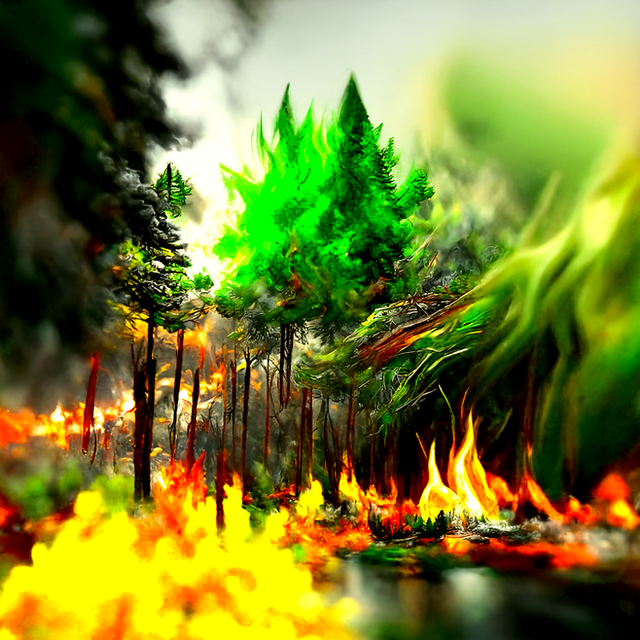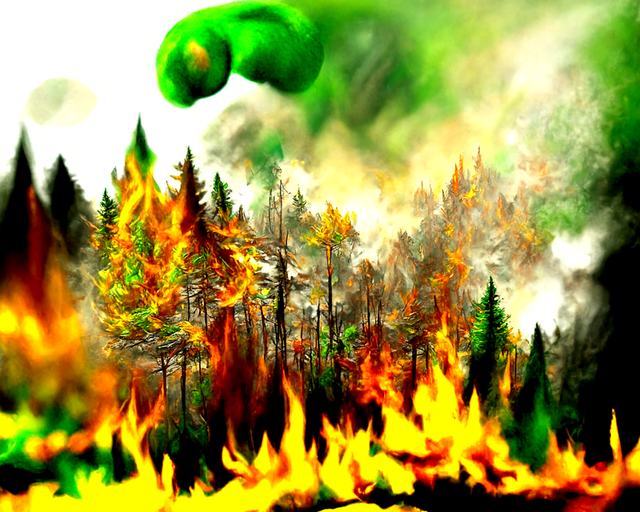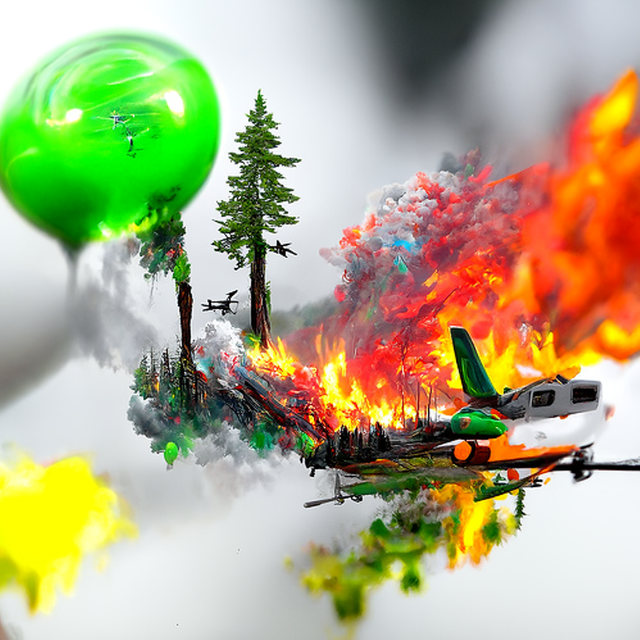Our lungs burn

Wildfires are a recurring problem around the world.
Every year people and animals die, and entire landscapes are destroyed.
Wildfires are a recurring topic in the news. Be it in Australia, California, or here in Germany.
But what is the cause of these fires? Of course, factors such as drought
and high temperatures also play a role, but it is often a human activity that causes forest fires.
The causes of forest fires are varied. Natural causes such as lightning strikes, volcanic eruptions,
or extreme drought can cause trees and other plants to catch fire.
Human causes such as arson, negligence, or carelessness
can also lead to forest fires.
Unfortunately, it happens again and again that young people start
fires in the forest and are not really careful.
It can quickly happen that the flames get out of control and destroy a large part of the forest.
Even careless drivers can cause forest fires with their cigarette butts or smoldering ashtrays.
Forest fires can spread very quickly and cause major damage.
They endanger not only the trees and plants but also the animals and people in the area.
Therefore it is important that when there is a forest fire,
you can act as quickly as possible and extinguish it as quickly as possible.
Forests are burning more frequently and larger. In Europe, around 500,000 hectares
of forest burn every year - in Germany it is around 10,000 hectares.
The causes of the fires are often man-made: arson, negligence, or even intentional.
Forces of nature such as lightning strikes, which can start a fire, are becoming more
and more frequent. Once a fire has started, it is tough to bring it back under control.
The fire is often carried further by the wind and can thus destroy large areas.
The causes of the fires are often man-made: arson, negligence or even intentional.
Forces of nature such as lightning strikes, which can start a fire,
are becoming more and more frequent. Once a fire has started, it is challenging
to bring it back under control. The fire is often carried further by the wind
and can thus destroy large areas. The causes of the fires are often man-made:
arson, negligence or even intentional. Forces of nature such as lightning strikes,
which can start a fire, are becoming more and more frequent.
Once a fire has started, it is challenging to bring it back under control.
The fire is often carried further by the wind and can thus destroy large areas.

It's a nightmare repeating itself: forest fires reduce large areas to rubble and ash.
People are losing their homes, animals their habitat.
In recent years, fires have been increasing worldwide – both in frequency and intensity.
Experts attribute this to the climate crisis. According to a study by the
University of Colorado at Boulder, wildfires will be more frequent, stronger, and longer in the coming decades.
Forest fires are a natural consequence of vegetation dynamics on Earth.
However, wildfire conditions are changing as a result of global warming.
The increase in temperature reduces moisture in vegetation and increases evaporation.
In addition, the number of dry days is increasing, which increases the risk of forest fires.
As a result of global warming, wildfires tend to burn longer and burn larger areas.
The increase in temperature also has a direct impact on the causes of fire.
Drought leads to an increased number of lightning strikes, which can start a fire.
In addition, extreme weather conditions, such as hot and dry periods,
are also the cause of forest fires. Global warming and its impact on wildfires
have already had devastating consequences. In 2017, there were more than 10 million
hectares of wildfires worldwide, doubling the area that burns each year on average.
This increase has also led to an increase in fire victims. In 2017, more than
13,000 people died in wildfires worldwide, more than triple the average death toll.
Wildfires have become more frequent in recent years and the effects are catastrophic.
According to a study by the University of Geneva, more than
300,000 animals die in forest fires every year. The study goes on to say that up to 15 percent
of all mammal and insect species are at risk of extinction if wildfire trends continue.
that burns on average every year. This increase has also led to an increase in fire victims.
In 2017, more than 13,000 people died in wildfires worldwide,
more than triple the average death toll. Wildfires have become
more frequent in recent years and the effects are catastrophic.
According to a study by the University of Geneva, more than 300,000 animals die
in forest fires every year. The study goes on to say that up to
15 percent of all mammal and insect species are at risk of extinction
if wildfire trends continue. that burns on average every year.
This increase has also led to an increase in fire victims. In 2017,
more than 13,000 people died in wildfires worldwide, more than triple
the average death toll. Wildfires have become more frequent in recent years
and the effects are catastrophic. According to a study by the University of Geneva,
more than 300,000 animals die in forest fires every year. The study goes on to say
that up to 15 percent of all mammal and insect species are at risk of extinction if
wildfire trends continue. Wildfires have become more frequent in recent years
and the effects are catastrophic. According to a study by the University of Geneva,
more than 300,000 animals die in forest fires every year.
The study goes on to say that up to 15 percent of all mammal and insect species
are at risk of extinction if wildfire trends continue. Wildfires have become more
frequent in recent years and the effects are catastrophic. According to a study by
the University of Geneva, more than 300,000 animals die in forest fires every year.
The study goes on to say that up to 15 percent of all mammal
and insect species are at risk of extinction if wildfire trends continue.
Wildfires are commonplace in Australia, but the 2019/2020 fires were particularly bad.
Many animals, especially koalas, lost their lives.
The images of dead and injured koalas went around the world and shook people up.
It is now clear that more than a billion animals died in Australia in the severe fires of 2019/2020.
Global attention has waned, but the Amazon fires continue to blaze,
claiming more and more victims. 265 animal and plant species that are
particularly badly affected by the fires. 124 of these occur exclusively in the Amazon region.
Many of them are already threatened with extinction.
Locals are displaced, animals die an agonizing death and the rainforest – our protective lungs – burns.
The devastating forest fires of recent years in California,
Portugal, Spain and Greece have shown one thing: when it comes to forest management,
something has to change. The aim of forestry must be to reduce susceptibility
to fire and increase the resilience of the ecosystem by maintaining and
developing natural forests with a natural combination of tree species.
This will not only improve environmental and climate protection
but also strengthen the local economy and create jobs.
Measures are already being taken in some countries to prevent slash and burn.
Laws prohibit the conversion of forest into agricultural land,
and the conversion of forest burned areas into building
land is no longer permitted in many countries. In addition,
there are harsh penalties and strong law enforcement to deter premeditated arson.
These measures are necessary to ensure that the forest is preserved and the risk of forest fires is minimized.
Some countries have already recognized the risk of forest fires
can be minimized through appropriate land use planning.
In Sweden, for example, the rules for building settlements in fire-prone
areas have been tightened. In Finland, too, the construction of new houses
and other infrastructure takes into account that railway lines
and power lines can cause forest fires. In Germany, however, the situation is still largely unregulated.
While there are some guidelines for spatial planning in fire-prone areas,
these are often not followed. New settlements are still being built in fire-prone areas,
and the construction of railways and power lines often does
not take sufficient account of the possible consequences.
To minimize the risk of forest fires, it is therefore important that spatial
planning in fire-prone areas is improved. Untouched forests should no longer be developed,
and the possible impact on forest fire risk should always be considered
when establishing new settlements and other infrastructure.
Fighting forest fires is an enormous challenge. It is all the more important that
responsibilities are clearly assigned and all the bodies involved
(authorities, fire brigade, citizens) work in a well-coordinated manner.
The monitoring of forest fire risk areas must be improved and intensified.
In addition, more financial resources and human resources are needed
to quickly extinguish forest fires in the early stages.
This is the only way to reduce the risk of large-scale damage in the future.
Ammunition and ordnance pose a major risk for forest fires.
Many of these areas are unguarded and can therefore be easily ignited.
It is important that sufficient financial resources and human resources
are available to monitor these areas and extinguish them in good time. Not only are plants important
to the aesthetics of a forest,
but they can also help prevent wildfires.
Their roots keep the ground firm and stable, which helps prevent trees from falling over
and starting fires as easily. Also, plants produce moisture that keeps
the soil moist and reduces the risk of wildfires. There are some plants that are
particularly good at preventing forest fires. These include indicator plants
such as hawthorn (Crataegus monogyna), cowslip hawthorn (Crataegus oxyacantha),
and blackthorn (Rhamnus frangula). Indicator plants are used to
assess the current environmental conditions in forests. They provide information
about the nitrogen content of the soil, air pollution, wetness, and dryness.
With the help of these plants, the phenological development of the forest floor
and the canopy can be estimated. The spread of forest fires can thus be better estimated.
Even if forest fires have become more frequent in recent years, work is still being done
on new inventions that are intended to fight or even prevent forest fires.
Forest fire robots, fire extinguishing rockets or forest fire index are just a few of these ideas.
A start-up from the Allgäu has developed a new system to prevent forest fires.
With the help of artificial intelligence (AI) and drones, the system should be able
to identify areas that are at high risk of forest fires. In the future it should then be
possible to patrol these areas in good time and thus prevent a fire. The new system
should be able to identify areas that are particularly vulnerable to forest fires.
Various factors are taken into account, such as vegetation, soil conditions and
climate. Based on these factors, the AI can then identify which areas are at high
risk and which are not. In the future, it should then be possible to patrol these
areas with the help of drones. The drones should be equipped with cameras,
able to detect small sources of fire. If a fire is discovered, the fire brigade can be alerted
immediately and prevent a fire.

The unmanned crawler fire engine can be a really effective tool to fight forest fires.
Above all, it can help in munitions-loaded areas.
Droplet extinguishing principle is an extinguishing principle in which small water particles hit the fire at high speed and thereby extinguish it. This principle has been used in firefighting since the 1990s
and has proven effective ever since. There are now various devices that use this principle to extinguish fires.
Another idea would be the combination of an airplane dropping so-called "depth bombs"
which make use of the droplet extinguishing principle.
The start-up Wildfire Suppression Ltd. from Sydney relies on depth charges.
The company has developed a new extinguishing agent that should help with forest fires.
The depth charges are dropped over the fire with a helicopter and
are intended to extinguish the fire.
When the depth charges land, the oxygen is briefly displaced by atomization
of the water charge at 300 m/s in all directions, which leads to the separation of flames and fuel.
The simultaneous cooling of the fuel is intended to prevent renewed ignition.
Another invention is gel. This is filled into the water bombs and should smother the flames
when it comes into contact with the fire. The gel is biodegradable and should therefore
not cause any damage to the environment. It should also be non-toxic and therefore
not pose a danger to people living in the vicinity of the fire.
The extinguishing agent is currently still in the test phase and its
effectiveness is being checked. Should it prove effective, it could be of great help
in fighting forest fires in the future.
Satellites can detect forest fires at an early stage and thus better inform the fire brigade.
This allows you to extinguish the fires faster and limit the damage. @ElonMusk Can you help us?
The Brandenburg environmental authority relies
on technology that is supposed to use sensors against forest fires.
The first wind turbines and mobile phone masts have already
been equipped with the sensors and the authority is confident that all
potentially fire-prone areas of the state will soon be able to be monitored.
It is terrible what has happened to the forest fires in Europe in the last few weeks.
The environment and nature are suffering from the tremendous damage caused by the fire.
Many animals have died or had to leave their homes. It is sad that so much suffering has arisen.
But there is also hope. Because we humans can do
something to improve the situation. We have to be careful that something like
this doesn't happen again. And we must work together to protect the environment.
This is the only way we can prevent more forest fires from occurring in the future.
All in all, the forest fire is a disaster that has us all concerned.
We must take care of the environment and deal with the aftermath of this tragedy.
The loss of nature is a heavy blow, but we must not give up hope.
Maybe the situation will improve soon and we can limit the damage.
"When the forest fire broke out, it was as if the earth itself was on fire.
The trees writhed in pain and the air was thick with smoke and ash. It was a disaster that devastated the heart of the forest. " Mokus Green
This is a one-time notice about a free service on steem.
There are communities that help support the little guy 😊, you might like ours, we join forces with lots of other small accounts to help each other grow!
Finally a good curation trail that helps its users achieve rapid growth, its fun on a bun! check it out. https://plu.sh/altlan